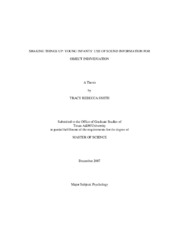| dc.description.abstract | Object individuation, the capacity to determine whether two perceptual
encounters belong to the same object or two different objects, is one of the most basic
cognitive abilities and provides a foundation for infants’ understanding of the physical
world. Yet very little work has been done to explore infants’ use of auditory information
to individuate objects. The first research to investigate infants’ use of sound information
to individuate objects was reported by Wilcox et al. (2006), who used a violation-ofexpectation
task to examine the extent to which 4.5-month-olds use differences in sound
to individuate objects. The results suggested that 4.5-month-olds use property-rich
sounds (sounds intimately related to an objects’ physical, amodal properties) but not
property-poor sounds (sounds that are more contrived) to distinguish the identity of
objects involved in occlusion events.
The current study investigated infants’ sensitivity to these two types of sounds
within the context of a search task. Three experiments were conducted with infants aged
5 to 7 months. The outcome of these experiments builds and extends on the findings of
Wilcox et al. in three ways. First, converging evidence was obtained, using a search task, that young infants are more sensitive to property-rich than property-poor sounds.
Second, more detailed information was obtained on infants’ interpretation of samesounds
events (two identical, rather than two different, sounds). Finally, possible
explanations for infants’ greater sensitivity to property-rich sounds were assessed. The
outcome of these studies, collectively, provides insight into the types of sounds that
infants use to identify objects and the reasons why some sounds are more salient to
infants than others. | en |


